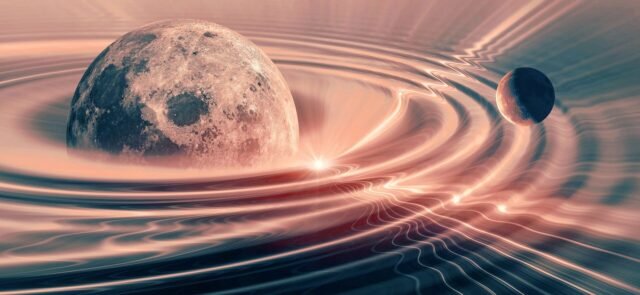
In a groundbreaking discovery, astronomers have identified gravitational waves emanating from a unique and rare cosmic event: the collision between a black hole and a neutron star. This celestial occurrence, marking a significant milestone in astrophysics, offers new insights into the fabric of our universe and the enigmatic objects it contains.
On June 29, 2021, the scientific community was captivated as gravitational waves, those ripples in spacetime predicted by Albert Einstein over a century ago, were detected from the merger of a black hole with a neutron star. This detection was not only a scientific triumph but also a cosmic spectacle, providing a first-of-its-kind glimpse into the interactions between these colossal objects. The observations were made possible by the collaborative efforts of LIGO (Laser Interferometer Gravitational-Wave Observatory), Virgo, and KAGRA observatories, which spotted these events on January 5 and January 15, 2020, more than 900 million light-years away from Earth (Science News).
Until this discovery, gravitational wave detections had been confined to mergers of similar celestial bodies: either two black holes or two neutron stars. The theoretical predictions of such cosmic ballets, where a black hole consumes a neutron star, had remained unobserved, making this finding a landmark in astrophysical research. The two events detected within ten days of each other signify not only the first observed mergers of a black hole with a neutron star through gravitational waves but also the very first observation of such mergers by any means (Science News).
This revelation not only broadens our understanding of the universe’s most violent and energetic events but also sheds light on the formation and evolution of these mysterious celestial objects. It’s believed that such mergers occur more frequently than previously thought, roughly once a month within a billion light-years of Earth. This frequency indicates a cosmic dance that is more common in the universe than previously known, opening new avenues for research and understanding of the cosmos (Science News).
One of the most fascinating aspects of these collisions is the potential for a “kilonova” event, a phenomenon that occurs when a black hole rips a neutron star apart, hurling chunks of neutron-rich material into space. This material, under the right conditions, can undergo nuclear reactions that form heavy elements like gold and platinum. One such event, observed in the aftermath of a neutron star collision (different from the black hole-neutron star mergers), confirmed that such cosmic collisions could be the universe’s way of producing rare earth elements and other heavy metals. The discovery underlined the importance of gravitational waves as a new tool for understanding the cosmic origins of elements.
The detection of gravitational waves from the merger of a black hole and a neutron star opens new chapters in our quest to understand the universe’s mysteries. These cosmic events not only validate the predictions of general relativity but also provide a unique window into the processes that shape the cosmos, from the formation of dense stellar remnants to the creation of the elements that make up our world. As gravitational wave astronomy continues to evolve, we can expect more revelations about the dark and dense objects that inhabit the cosmos, bringing us closer to unlocking the secrets of the universe’s most elusive phenomena.








